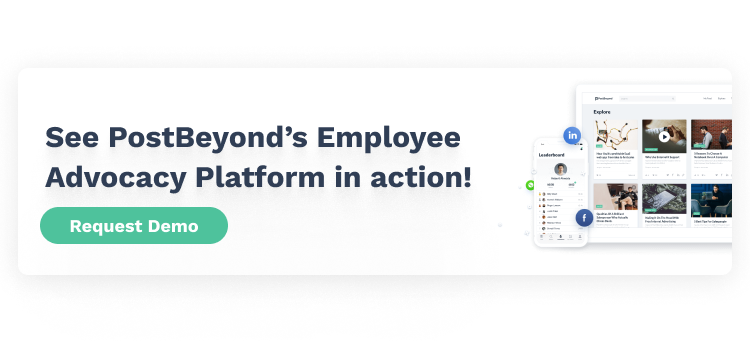How to Roll Out Your Employee Advocacy Program
Table of Contents:
Introduction
Organizations are quickly realizing the value of launching employee advocacy on social media.
In just the past year, maturity of employee advocacy programs more than doubled from 18% in 2015 to 45% today. It’s clear that enterprises have identified the critical need for solutions that modernize the way they communicate with employees.
Employee advocacy tools not only allow employees to share company content on social media, these tools improve the flow of communication within the organization. They offer an experience that’s mobile, social, and visual – which is how your workforce is accustomed to communicating outside of work.
With employee advocacy tools, information and content that your workforce wants is available on their smartphone, tablet, or desktop in rich, engaging formats. And you now have the insight as to who’s seen the content, who has shared it with their networks, and which content types perform best.
It’s a complete transformation of how large companies communicate with their workforce – and it works.
If you’re one of the organizations who has decided to go ahead with launching employee advocacy on social media (or even if you’re considering implementing a program like this), this guide will walk you through the necessary steps to getting your program off to a strong start and ensuring that you achieve sustainable growth.
Let’s get started!
Building Your Employee Advocacy Groups
You can likely think of a handful of employees who are already visibly proactive and engaged.
These are the folks that attend every company event, volunteer their time to lead company initiatives, or regularly share news about the organization on social media.
Naturally, these are the employees who we can assume would be the first ones interested in joining an employee advocacy program.
But there are others in your organization who have high potential to be this engaged and may need a bit more nurturing. The same report found that an additional 26% of employees have a high engagement level, but may not be as active online.
This could mean that they are enthusiastic about where they work, they are highly engaged in face-to-face conversations or company events, but they may not share anything about work on social media.
These employees are likely interested in joining the program, but will need additional support and resources for online best practices.
Online external engagement is central to employee advocacy on social media. We recommend taking the time to understand employees’ concerns around social media, and providing them with the training and guidance they need to feel comfortable sharing.
The best approach is to cast a wide net to ensure that you capture anyone who’s interested.
Once you’ve gauged who’s interested, you’ll want to invite them to your program’s kick-off or launch. The launch is an opportunity for your employees to learn more about employee advocacy and what it means for them.
Here are some things to consider when inviting employees to your program launch:
- What channel would be the best way to get their attention?
- Intranet
- Internal Social Network
- Townhalls or Company Events
- Team Huddles (lead by Managers)
- Who’s the best person to introduce this exciting new program?
- C-Level
- Team Leads
- Hand-Selected Peers
- Do you need to check in with anyone before you invite employees?
- Set up some time with HR, maybe legal
- Supporting roles who know the ins and outs of that group
- Translation teams if launching in multiple languages
Launching Employee Advocacy on Social Media
How your program is positioned during the launch is critical to high adoption and early success.
An interactive and informative launch helps employees understand what the program is meant to accomplish, and how it’s going to help them
The style of launch event you’ll have depends on how your workforce is distributed.
If you have a large group of employees in centralized offices who you’re onboarding, then it makes sense to have what we’ve named a “Champagne Style” launch.
Champagne launches are interactive and engaging events hosted at every office where employees will be joining the program. The event’s focus is to educate your team on the overarching value and strategy around employee advocacy on social media.
Tips For Organizing a ‘Champagne Style’ Launch:
Set up different stations with different themes. Here are some examples:
- What’s the value of employee advocacy on social media?
- What is Social Selling?
- How does social media help recruiting?
- How do employee advocacy platforms work?
- Get to know our company’s social media policy
Offer live demos of the platform for your employees:
- If possible, have your Customer Success Manager from the platform join this session to answer questions around best practices.
Host social media workshops, such as:
- How to build an effective LinkedIn profile
- Key differences between social networks
- Set up a photo booth that lets employees take new headshots for their LinkedIn profile.
If your employees are distributed in different locations (like branches, stores, or even employees who work from home), then it makes more sense to host a remote launch.
Mobile-first launches are ideal for teams who are regularly out of the office, such as frontline staff at retail locations, or sales reps who are on the road.
Tips For Organizing a Remote Style Launch
Know Your Audience
Launching to a remote workforce in different geographic areas is no easy feat.
If a technology was launched in the past few years to this remote group, then learn what worked from those program admins so that you can onboard efficiently
Use Preferred Communication Methods
Make use of existing communication methods that these employees prefer.
For example: team huddles, intranet landing pages, weekly status reports. Use these tried-and-true mediums to start introducing the program.
Keep it Short and Sweet
This group won’t have a lot of time, so we recommend a 2-3 minute video that articulates the value, and shows a quick demonstration of how the app works.
Follow up via email with more detail on the program.
Make the App Easily Available
If your organization uses its own Enterprise App Store (EAS), then make sure your employee advocacy app is available for download. This will ensure that remote workers can access the app on their preferred device.
Set up a Training Session
Hose an online Lunch-and-Learn with the program manager and platform’s Customer Success rep. End the training call with actionable next steps: sign up, browse content, connect your networks, and share your first post.
Be sure that you keep training guides or materials on hand for future use. As your program grows, you’ll have more users onboarding who need social media training. Any presentations or documents will come in handy!
Grow Employee Advocacy on Social Media

In order for your program to have lasting success, it needs to become part of your employees’ everyday workflow. The launch event is important to get your team on board, but it’s equally important to constantly measure success and iterate where needed.
It’s a balance between quick wins (i.e., high initial adoption rate) and enterprise-wide adoption (acquiring more users, habitual sharing.) Here’s what we recommend to help ensure that your program gets off to a strong start and grows at a sustainable rate:
Set Program Goals
Identify your impactful first project.
- What will be your first quick win?
- Is it high profile enough that those not involved with the program can understand its significance?
Understand your program’s maturity model.
Cross-functional alignment.
- Are there any other departments you can engage with so that you can gain a more diverse perspective? Strong programs have had a program office that includes: corporate communications, innovation teams, HR and legal.
- Not everyone needs to be involved every step of the way, but it’s great to get feedback from various stakeholders early on.
Lead Change Management
- Will this program require new roles?
- If so, what will these roles look like? Do you need to hire?
- How will employee advocacy on social media impact current workflows? What is the most efficient way to integrate program management into day-to-day activities?
- How will those who belong to the program management team keep each other accountable?
- How will you measure success?
Plan for Growth
How will you leverage your first success?
Don’t be shy about early wins. Sharing your first success stories will help those lagging adopters to join, and can get you a spotlight at the next executive meeting.
Prepare for multiple roll-outs.
This is when it makes sense to start thinking about multi language support. Work with your translation team for onboarding materials and make sure your platform supports multiple languages.
Gain sponsorship and buy-in from your executives.
This goes beyond just securing approvals and resources. Your executives can be your strongest champions if they sign onto your employee advocacy. In other words, they can help drive up adoption rates.
Find a way to report on the program with numbers only, then add context.
Go back to your overarching goals and align that with your organization’s priorities. If you’re trying to generate leads, show how many leads came through your employee advocacy platform. If you’re trying to engage your employees, then measure time spent in-app, articles suggested and/or shared.
Defining these goals is critical to ensuring that employee advocacy on social media lasts long after the launch. In fact, the best is yet to come.
Involving stakeholders from different areas in your program’s launch and growth planning directly impacts how quickly you hit the critical mass that’s necessary for success across the organization.
The more business units and champions who are involved at the program’s inception, the higher the volume of employees who will talk about and continue to ensure enterprise-wide adoption.


